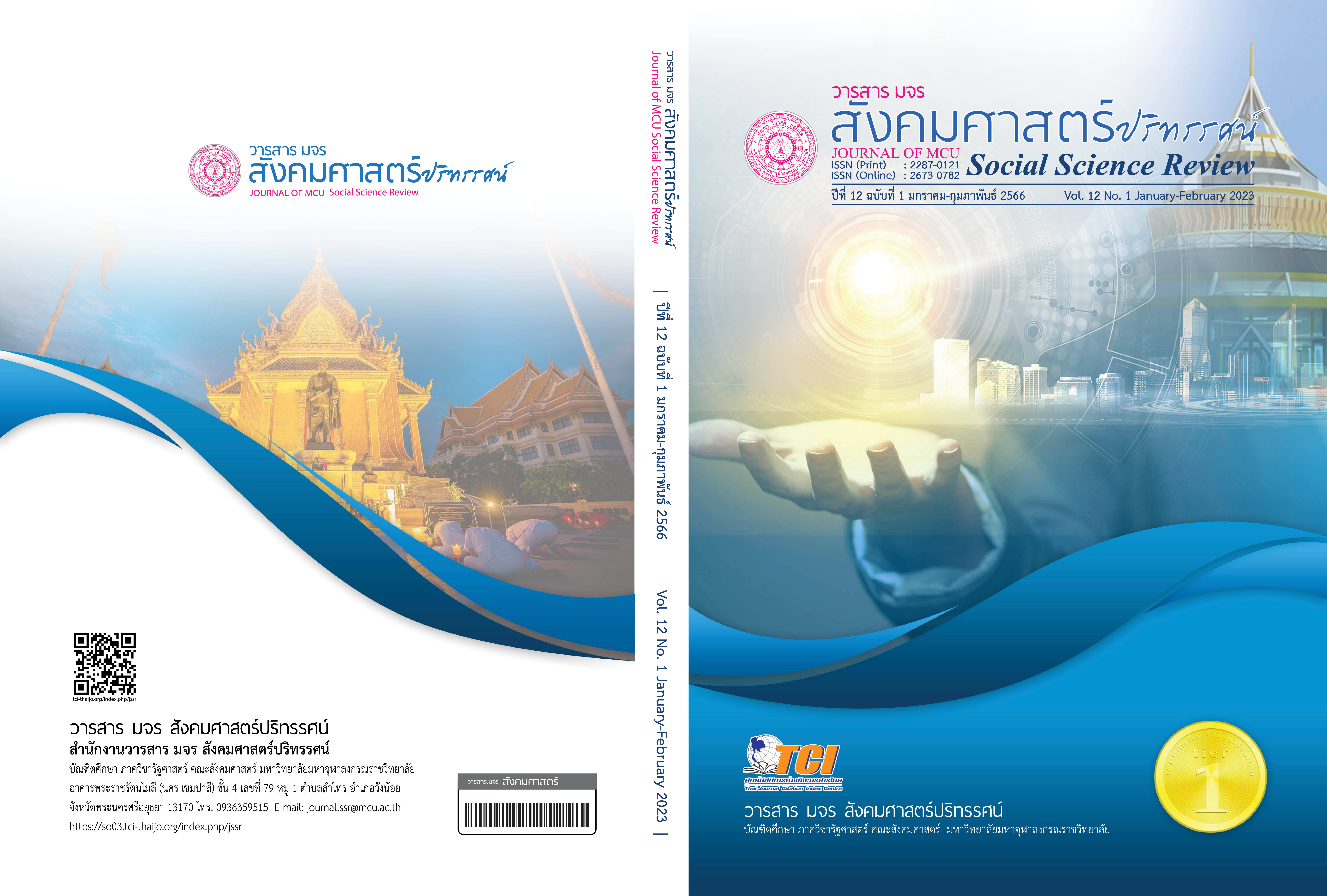การพัฒนาพุทธศาสนิกชนไทยในปัจจุบัน
คำสำคัญ:
การพัฒนา, พุทธศาสนิกชน, หลักพุทธธรรม, การบูรณาการบทคัดย่อ
บทความวิจัยนี้มีวัตถุประสงค์เพื่อ 1. ศึกษาการพัฒนาพุทธศาสนิกชนไทยในปัจจุบัน 2. ศึกษาหลักพุทธธรรมส่งเสริมการพัฒนาพุทธศาสนิกชนไทยในปัจจุบัน 3. บูรณาการการพัฒนาพุทธศาสนิกชนไทยในปัจจุบันด้วยหลักพุทธธรรม 4. นำเสนอแนวทางการสร้างองค์ความรู้เกี่ยวกับ “รูปแบบการบูรณาการพัฒนาพุทธศาสนิกชนไทยในปัจจุบันด้วยหลักพุทธธรรม” เป็นการวิจัยเชิงคุณภาพแบบเอกสาร มีการสัมภาษณ์เชิงลึก จำนวน 16 รูป/คน และจัดเสวนากลุ่มย่อย จำนวน 6 รูป/คน โดยนำข้อมูลมาศึกษาวิเคราะห์ สังเคราะห์ และสรุปอภิปรายผลเชิงพรรณนา
ผลการวิจัยพบว่า พุทธศาสนิกชนไทยในปัจจุบันขาดการพัฒนาในหน้าที่ของการเป็นพุทธศาสนิกชน ต้องใช้หลักพุทธธรรมมาบูรณาการเพื่อพัฒนาด้านการศึกษา การปฏิบัติ การเผยแผ่ และการปกป้อง พระพุทธศาสนา โดยใช้หลักปัญญา 3 หิริ โอตตัปปะ สัปปุริสธรรม 7 อัตถะ 3 และ อริยสัจจจ 4 สามารถสร้างเป็นองค์ความรู้ใหม่ในแบบของ MAN MODEL ทั้งนี้ การนำหลักพุทธธรรมมาบูรณาการเป็นสิ่งที่สมควรเพราะทำให้เกิดการปรับทัศนคติพุทธศาสนิกชนไทยในปัจจุบัน การได้ลงมือปฏิบัติ และหน่วยงานที่เกี่ยวข้อง มีการสนับสนุนในรูปแบบต่าง ๆ สรุปได้ว่าการใช้หลักพุทธธรรมเข้ามาบูรณาการนับเป็นแนวทางที่สามารถพัฒนาการทำหน้าที่ของพุทธศาสนิกชนได้อย่างสมบูรณ์ทั้ง 4 ด้าน
เอกสารอ้างอิง
แก้ว ชิดตะขบ. (2557). คู่มือพุทธศาสนิกชน (พิมพ์ครั้งที่ 7). กรุงเทพฯ: โรงพิมพ์สำนักงานพระพุทธศาสนา.
ธงชัย สมบูรณ์. (2532). การศึกษาเพื่อการพัฒนา. กรุงเทพฯ: สำนักพิมพ์มหาวิทยาลัยรามคำแหง.
ธิดารัตน์ เทพรัตน์. (2560). ทฤษฎีการพัฒนา. สืบค้น 30 มิถุนายน 2562, จาก http://www.Thaidarat00.wordpress.com/2011/11/16/ทฤษฎีการพัฒนา/.
บัญชายุทธ์ อังคะนาวิน (2563, 26 พฤษภาคม). หัวหน้างานทะเบียนที่ดินวัดร้าง สำนักงานพระพุทธศาสนาแห่งชาติ. [การสนทนากลุ่ม].
ประพันธ์ ตั้นวัฒนา. (2563, 26 พฤษภาคม). ผู้ตรวจราชการสำนักงานพระพุทธศาสนาแห่งชาติ.[การสนทนากลุ่ม].
ปวรุตม์ ฐิติพงศ์ศิริกุล. (2563, 26 พฤษภาคม). หัวหน้าฝ่ายอุทยาน สำนักงานพระพุทธศาสนาแห่งชาติ. [การสนทนากลุ่ม].
พระเทพปริยัติโมลี (2563, 1 เมษายน). รองเจ้าคณะภาค 9. [สัมภาษณ์].
พระพรหมคุณาภรณ์ (ป.อ. ปยุตฺโต). (2553). หลักชาวพุทธ : จุดเริ่มจุดร่วม ที่มารวมกันรุ่งโรจน์. กรุงเทพฯ: สำนักพิมพ์พิมพ์สวย.
______. (2559). พจนานุกรมพุทธศาสน์ ฉบับประมวลธรรม (พิมพ์ครั้งที่ 34). กรุงเทพฯ: โรงพิมพ์มหาจุฬาลงกรณราชวิทยาลัย.
พระมหาไพรวัลย์ วรวณฺโณ. (2562, 13 ธันวาคม). [สัมภาษณ์].
พระมหาวิมล โชติธมฺโม. (2563, 26 พฤษภาคม). พระธรรมวิทยากร. [การสนทนากลุ่ม].
พระเลิศพิพัฒน์ จนฺทปญฺโญ. (2554). บทบาทของพระสงฆ์ในสังคมโลกาภิวัตน์. วาสารการศึกษาและพัฒนาสังคม มหาวิทยาลัยบูรพา, 7(2), 1-9.
พระอภัย อภิชาโต (ชูขุนทด). (2554). การศึกษาหลักธรรมสำหรับพัฒนาพฤติกรรมของมนุษย์ในสังคมปัจจุบัน (วิทยานิพนธ์พุทธศาสตรมหาบัณฑิต). พระนครศรีอยุธยา: มหาวิทยาลัยมหาจุฬาลงกรณ์ราชวิทยาลัย.
ภาณุพงศ์ คงเชื้อจีน (2563, 30 เมษายน). ผู้อำนวยการกองส่งเสริมงานเผยแผ่พระพุทธศาสนา สำนักงานพระพุทธศาสนาแห่งชาติ. [สัมภาษณ์].
ยงยุทธ วัชรดุล. (2548). องค์พุทธมามกะ/ความมั่นคงของพระพุทธศาสนาในประเทศไทย.กรุงเทพฯ: บริษัทโพสต์ พับลิชชิง.
สัญชัย พรหมฤาษี (2563, 14 เมษายน).ประธานกรรมการมูลนิธิเพื่อพระพุทธศาสนา. [สัมภาษณ์].
อนุรักษ์ สบายสุข. (2552). ความคิดเห็นของพุทธศาสนิกชนต่อข่าวสารพฤติกรรมที่ไม่เหมาะสมของพระสงฆ์ (วิทยานิพนธ์ศิลปศาสตรมหาบัณฑิต). กรุงเทพฯ: มหาวิทยาลัยรามคำแหง.
ดาวน์โหลด
เผยแพร่แล้ว
รูปแบบการอ้างอิง
ฉบับ
ประเภทบทความ
สัญญาอนุญาต
ลิขสิทธิ์ (c) 2023 วารสาร มจร สังคมศาสตร์ปริทรรศน์

อนุญาตภายใต้เงื่อนไข Creative Commons Attribution-NonCommercial-NoDerivatives 4.0 International License.
เพื่อให้เป็นไปตามกฎหมายลิขสิทธิ์ ผู้นิพนธ์ทุกท่านต้องลงลายมือชื่อในแบบฟอร์มใบมอบลิขสิทธิ์บทความให้แก่วารสารฯ พร้อมกับบทความต้นฉบับที่ได้แก้ไขครั้งสุดท้าย นอกจากนี้ ผู้นิพนธ์ทุกท่านต้องยืนยันว่าบทความต้นฉบับที่ส่งมาตีพิมพ์นั้น ได้ส่งมาตีพิมพ์เฉพาะในวารสาร มจร สังคมศาสตร์ปริทรรศน์ เพียงแห่งเดียวเท่านั้น หากมีการใช้ภาพหรือตารางหรือเนื้อหาอื่นๆ ของผู้นิพนธ์อื่นที่ปรากฏในสิ่งตีพิมพ์อื่นมาแล้ว ผู้นิพนธ์ต้องขออนุญาตเจ้าของลิขสิทธิ์ก่อน พร้อมทั้งแสดงหนังสือที่ได้รับการยินยอมต่อบรรณาธิการ ก่อนที่บทความจะได้รับการตีพิมพ์ หากไม่เป็นไปตามข้อกำหนดเบื้องต้น ทางวารสารจะถอดบทความของท่านออกโดยไม่มีข้อยกเว้นใดๆ ทั้งสิ้น





